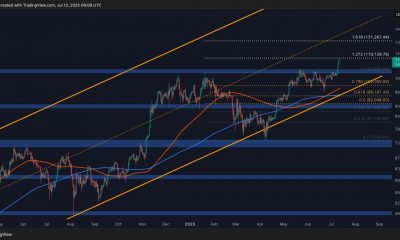Commodities
U.S. stock market closed with a decline. Dow Jones down 0.43%

The U.S. stock market ended Friday’s trading with a drop amid negative dynamics in the telecommunications, technology, and raw materials sectors. At the close of trading on the New York Stock Exchange, the Dow Jones fell 0.43%; the S&P 500 index declined 0.93%; and the NASDAQ Composite dropped 1.87%.
The top gainers among Dow Jones index components in today’s trading were shares of American Express Company (NYSE:AXP), which gained 2.83p (1.88%) to close at 153.01. Procter & Gamble Company (NYSE:PG) gained 2.25p (1.60%) to close at 143.02. International Business Machines (NYSE:IBM) gained 1.10p (0.87%) to close at 128.25.
Verizon Communications Inc (NYSE:VZ) shares were the fallen, down 3.21p (6.74%), ending the session at 44.45. Shares of Intel Corporation (NASDAQ:INTC) rose 1.41p (3.47%) to close at 39.20, while Nike Inc (NYSE:NKE) dropped 2.50p (2.24%) to close trading at 109.12.
The top gainers among the S&P 500 index components in today’s trading were shares of HCA Holdings Inc (NYSE:HCA), which gained 11.43% to 202.03; Schlumberger NV (NYSE:SLB), which gained 4.28% to close at 35.07; and shares of PPG Industries Inc (NYSE:PPG), which gained 3.89% to close the session at 127.73.
SVB Financial Group (NASDAQ:SIVB) shares were the fallers, dropping 17.15% to close at 361.36. Shares of Seagate Technology PLC (NASDAQ:STX) lost 8.11% to close the session at 76.83. Meta Platforms Inc (NASDAQ:META) was down 7.59% to 169.27.
The top gainers among the components of the NASDAQ Composite index in today’s trading were Pagaya (NASDAQ:PGY) which gained 118.88% to 11.71. Kidpik Corp (NASDAQ:PIK) which gained 67.57% to close at 2.48; and Yoshitsu Co Ltd ADR (NASDAQ:TKLF) which gained 48.39% to close the session at 2.30.
Leading the decline were shares of VistaGen Therapeutics Inc (NASDAQ:VTGN), which declined 85.99% to close at 0.15. Shares of Meihua International Medical Technologies Co Ltd (NASDAQ:MHUA) lost 40.55% to end the session at 2.88. Kiora Pharmaceuticals Inc (NASDAQ:KPRX) was down 39.76% to 0.15.
On the NYSE, 1,963 stocks fell more than 1,172 that ended in the black, while 147 remained almost unchanged. On NASDAQ, 2,754 stocks were down, 999 were up, and 217 remained flat.
SVB Financial Group (NASDAQ:SIVB) stock traded down to a 52-week low, down 17.15% at 74.81p and closing at 361.36. Verizon Communications Inc (NYSE:VZ) shares fell to a 3-year low, down 6.74%, 3.21p, and ended trading at 44.45.
Pagaya (NASDAQ:PGY) shares rose to an all-time high, up 118.88%, 6.36p, and ended trading at 11.71. VistaGen Therapeutics Inc (NASDAQ:VTGN) shares fell to an all-time low, down 85.99%, 0.92p, and ended trading at 0.15. Shares of Meihua International Medical Technologies Co Ltd (NASDAQ:MHUA) fell to an all-time low, down 40.55%, 1.97p, and ended trading at 2.88. Kiora Pharmaceuticals Inc (NASDAQ:KPRX) stock prices fell to an all-time low, down 39.76%, 0.10p, and ended trading at 0.15.
The CBOE Volatility Index, which is based on S&P 500 options trading, fell 0.35% to 23.03, hitting a new 3-month low.
Gold futures for August delivery added 0.53%, or 9.15, to $1.00 per troy ounce. In other commodities, September WTIcrude oil futures traded down 1.71%, or 1.65, to $94.70 a barrel. Futures on Brent crude oil for September delivery fell by 0.58%, or 0.60, to $103.26 per barrel.
Meanwhile, on the Forex market, EUR/USD remained unchanged 0.18% to 1.02, while USD/JPY dropped 0.95% to 136.07.
The USD index futures were down 0.33% to 106.46.
Commodities
Oil prices rise; U.S. crude inventories plunge, Russia-Ukraine truce eyed
Commodities
India’s Reliance to stop buying Venezuelan oil over US tariffs, sources say
Commodities
Oil prices climb on Venezuela supply worries

 Forex3 years ago
Forex3 years agoForex Today: the dollar is gaining strength amid gloomy sentiment at the start of the Fed’s week

 Forex3 years ago
Forex3 years agoUnbiased review of Pocket Option broker

 Forex3 years ago
Forex3 years agoDollar to pound sterling exchange rate today: Pound plummeted to its lowest since 1985

 Forex3 years ago
Forex3 years agoHow is the Australian dollar doing today?

 Cryptocurrency3 years ago
Cryptocurrency3 years agoWhat happened in the crypto market – current events today

 World3 years ago
World3 years agoWhy are modern video games an art form?

 Commodities3 years ago
Commodities3 years agoCopper continues to fall in price on expectations of lower demand in China

 Economy3 years ago
Economy3 years agoCrude oil tankers double in price due to EU anti-Russian sanctions





























